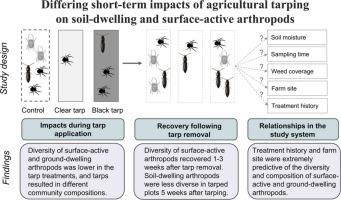Agriculture, Ecosystems & Environment ( IF 6.6 ) Pub Date : 2023-05-03 , DOI: 10.1016/j.agee.2023.108542 Eva Kinnebrew , Victor M. Izzo , Deborah A. Neher , Taylor H. Ricketts , Kimberly F. Wallin , Gillian L. Galford

|
Agricultural tarping, the practice of placing impermeable plastic tarps over crop beds before planting to suppress weeds, is rising in popularity. However, the use of tarps has uncertain effects on soil arthropod communities. We studied the impact of silage (black plastic) tarps and clear plastic tarps on surface-active and soil-dwelling arthropods by tracking immediate impacts and arthropod recovery for 5 weeks after tarps were removed. We also assessed how well environmental and experimental variables explained arthropod diversity and composition. During tarp application, we found that both silage and clear plastic tarps had significant negative impacts on surface-active arthropod diversity, while only clear plastic tarps impacted soil-dwelling arthropods. Surface-active arthropod diversity recovered by 1–3 weeks after tarping, but at 5 weeks after tarping soil-dwelling arthropod diversity was significantly lower in silage tarp and clear plastic plots than control plots. Tarps also led to compositional changes in the arthropod communities, though these changes were only significant during tarp cover. The variables that best explained arthropod diversity and community composition were treatment (i.e., silage tarp, clear plastic tarp, or control) and farm site. Other variables, such as soil moisture and weed coverage, were not consistently strong model predictors. These results imply that tarps may have temporary impacts on surface-active arthropods but potentially longer-lasting impacts on soil-dwelling arthropods. Continuing to monitor impacts of tarps on soil arthropods will better inform the sustainability of this practice.
中文翻译:

农业防水布对土壤和表面活性节肢动物的不同短期影响
农业防水布,即在种植前将不透水的塑料防水布放在作物床上以抑制杂草的做法,越来越受欢迎。然而,防水布的使用对土壤节肢动物群落的影响尚不确定。我们研究了青贮(黑色塑料)防水布和透明塑料防水布对表面活性节肢动物和土壤节肢动物的影响,方法是在防水布移除后跟踪直接影响和节肢动物恢复 5 周。我们还评估了环境和实验变量对节肢动物多样性和组成的解释程度。在防水布应用过程中,我们发现青贮饲料和透明塑料防水布对表面活性节肢动物多样性都有显着的负面影响,而只有透明塑料防水布会影响土壤节肢动物。表面活性节肢动物多样性在防水布后 1-3 周恢复,但在铺上防水布后 5 周,青贮防水布和透明塑料地块中的土栖节肢动物多样性明显低于对照地块。防水布还导致节肢动物群落的组成发生变化,尽管这些变化仅在防水布覆盖期间才显着。最能解释节肢动物多样性和群落组成的变量是处理(即青贮饲料防水布、透明塑料防水布或对照)和农场地点。其他变量,如土壤湿度和杂草覆盖率,并不是一贯强大的模型预测因子。这些结果表明防水布可能对表面活性节肢动物有暂时的影响,但可能对土壤节肢动物产生更持久的影响。继续监测防水布对土壤节肢动物的影响将更好地告知 防水布还导致节肢动物群落的组成发生变化,尽管这些变化仅在防水布覆盖期间才显着。最能解释节肢动物多样性和群落组成的变量是处理(即青贮饲料防水布、透明塑料防水布或对照)和农场场地。其他变量,如土壤湿度和杂草覆盖率,并不是一贯强大的模型预测因子。这些结果表明防水布可能对表面活性节肢动物有暂时的影响,但可能对土壤节肢动物产生更持久的影响。继续监测防水布对土壤节肢动物的影响将更好地告知 防水布还导致节肢动物群落的组成发生变化,尽管这些变化仅在防水布覆盖期间才显着。最能解释节肢动物多样性和群落组成的变量是处理(即青贮饲料防水布、透明塑料防水布或对照)和农场场地。其他变量,如土壤湿度和杂草覆盖率,并不是一贯强大的模型预测因子。这些结果表明防水布可能对表面活性节肢动物有暂时的影响,但可能对土壤节肢动物产生更持久的影响。继续监测防水布对土壤节肢动物的影响将更好地告知 或控制)和农场网站。其他变量,如土壤湿度和杂草覆盖率,并不是一贯强大的模型预测因子。这些结果表明防水布可能对表面活性节肢动物有暂时的影响,但可能对土壤节肢动物产生更持久的影响。继续监测防水布对土壤节肢动物的影响将更好地告知 或控制)和农场网站。其他变量,如土壤湿度和杂草覆盖率,并不是一贯强大的模型预测因子。这些结果表明防水布可能对表面活性节肢动物有暂时的影响,但可能对土壤节肢动物产生更持久的影响。继续监测防水布对土壤节肢动物的影响将更好地告知这种做法的可持续性。



























 京公网安备 11010802027423号
京公网安备 11010802027423号